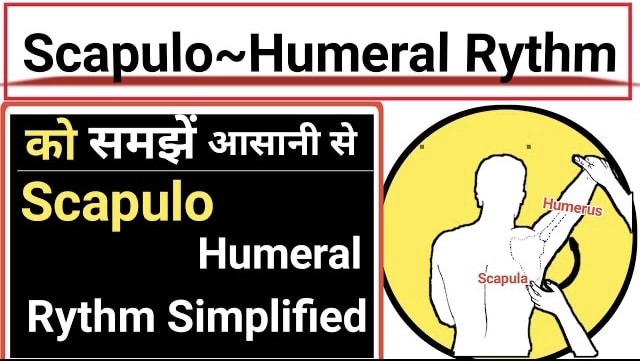Scapulo Humeral rythm ?
The coordinated movement between the scapula (shoulder blade) and the humerus (upper arm bone) during certain shoulder movements which are Known as Scapulo Humeral rythm
It is an important mechanism that helps to maintain optimal stability and function of the shoulder joint.
During shoulder abduction (lifting the arm out to the side) and flexion (lifting the arm forward) the scapula and humerus move in a specific pattern to allow for smooth and efficient movement.
Scapulo Humeral rythm involves the coordinated movement of three joints:
the glenohumeral joint (shoulder joint) the scapulothoracic joint (between the scapula and rib cage) and the acromioclavicular joint (between the acromion process of the scapula and the clavicle).
As the arm is raised the scapula rotates upward and externally rotates to allow greater clearance for the humeral head within the glenoid fossa of the scapula.
This movement is primarily controlled by the actions of the trapezius, serratus anterior and upper and lower fibers of the trapezius muscles.
The humerus simultaneously abducts or flexes following the upward rotation of the scapula.
Scapula and Humerus Movement Ratio
The scapulo-humeral rhythm is generally considered to be a 2:1 ratio meaning that for every 2 degrees of humeral movement, the scapula contributes 1 degree.
This ratio helps to distribute the forces and stresses evenly between the shoulder joint and the scapulothoracic joint reducing the risk of impingement and ensuring smooth movement.
It is important to note that the scapulo-humeral rhythm can be affected by various factors
such as muscular imbalances, shoulder pathologies or poor movement patterns.
These issues can disrupt the normal rhythm and lead to altered shoulder mechanics, pain and dysfunction.
Physical therapists and other healthcare professionals often assess and address scapulo-humeral rhythm
as part of shoulder rehabilitation programs to restore proper movement and function.
Certainly! In addition to understanding the basic mechanics of scapulo-humeral rhythm
significance and assessment Importance in Shoulder Function:
The scapulo-humeral rhythm is crucial for maintaining proper shoulder function and stability.
It allows for a wide range of shoulder movements while minimizing the risk of impingement and excessive stress on the surrounding structures.
Altered Rhythm and Shoulder Dysfunction:
When the scapulo-humeral rhythm is disrupted it can contribute to shoulder dysfunction and pain.
For example muscular imbalances or weakness in the scapular stabilizers
such as the trapezius or serratus anterior can lead to abnormal scapular movement patterns and compromise the rhythm.
This can result in conditions like shoulder impingement, rotator cuff injuries, or shoulder instability.
Clinical Assessment:
Healthcare professionals such as physical therapists or orthopedic specialists often assess the scapulo-humeral rhythm during a thorough shoulder examination.
They observe and analyze the coordination between scapular and humeral movement during various shoulder motions such as abduction, flexion or overhead activities.
Any abnormalities or limitations in the rhythm can provide important diagnostic information and guide treatment planning.
Rehabilitation and Treatment:
Correcting scapulo-humeral rhythm dysfunction is often an integral part of shoulder rehabilitation programs.
Treatment strategies may include strengthening exercises for the scapular stabilizer
improving scapular control and positioning and optimizing overall shoulder mechanics.
Specific exercises targeting muscle imbalances and movement patterns are prescribed to restore the proper rhythm and enhance functional shoulder movement.
Individual Variations:
While a 2:1 ratio is commonly cited for the scapulo-humeral rhythm, it is essential to recognize that there can be individual variations.
Factors like anatomical variations, injuries, or specific shoulder pathologies can influence the rhythm.
Therefore, treatment plans should be tailored to address the specific needs and characteristics of each individual.
It’s worth noting that discussing scapulo-humeral rhythm with a healthcare professional
such as a physical therapist or orthopedic specialist, can provide more comprehensive and personalized insights based on your specific circumstances.

1 thought on “Scapulo Humeral rythm ?”
Comments are closed.